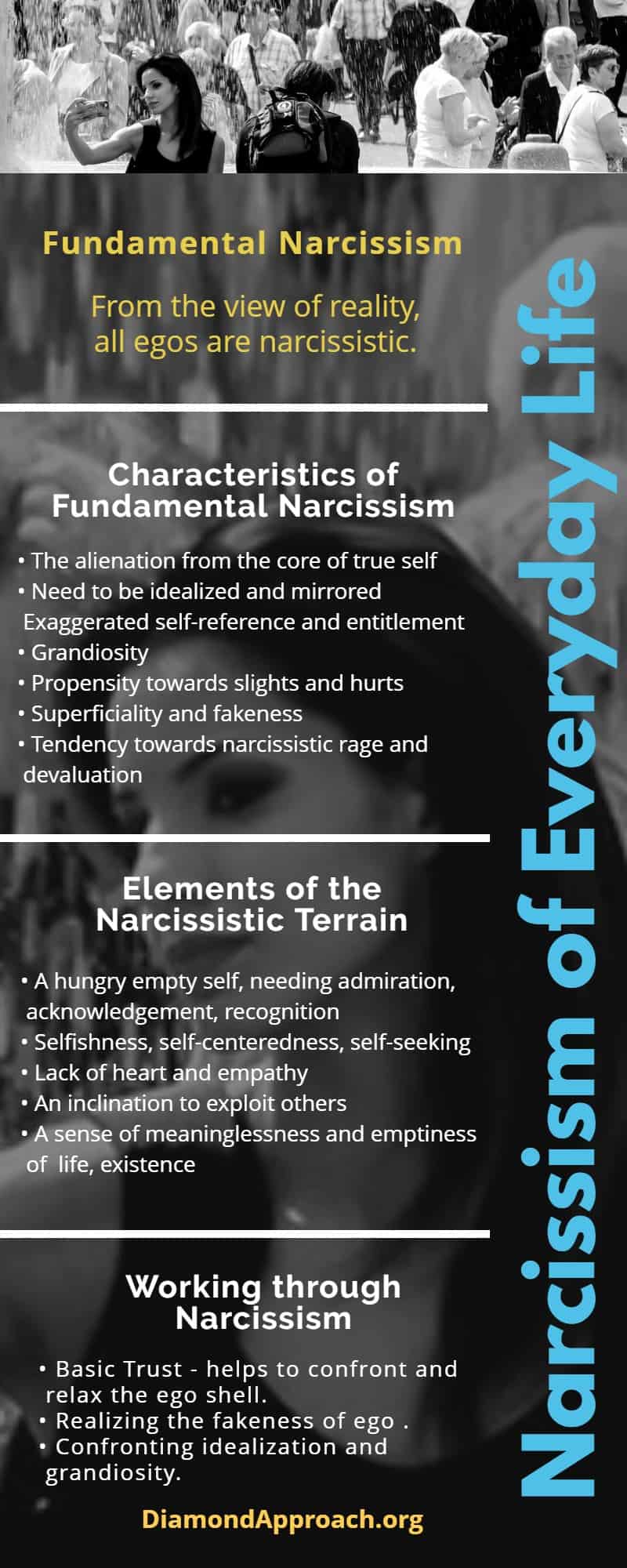Narcissism: Self Lost in a Shell-self.
From whimsical selfies to living in a fractured world with recreational outrage and toxic tribalism*, narcissism reflects the core obstacle to real authenticity, wholeness, and personal satisfaction.
 From the view of reality, all egos are narcissistic.
From the view of reality, all egos are narcissistic.
*A loyalty to one's own tribe or social group to the point that dogma and dysfunction become the standard.
Narcissism:
- Excessive interest in or admiration of oneself and one's physical appearance.
- Psychology: selfishness, involving a sense of entitlement, a lack of empathy, and a need for admiration, as characterizing a personality type.
- Psychoanalysis: self-centeredness arising from failure to distinguish the self from external objects, either in very young babies or as a feature of mental disorder.
The Narcissism of Everyday Life

The self-reflective capacity of our minds lends itself to the dynamics of narcissism. Ego self is based on mental structures and images, memories, arrested development, body tension patterns, and a host of attitudes and convictions.
The average person on the street is fundamentally narcissistic, continually engaged, either consciously or unconsciously with these narcissistic phenomena:
- Selfishness
- Self-reference
- A need to be seen
- A wish for esteem and admiration
We can understand “fundamental narcissism” as the disconnection from our deeper nature. “Pathological narcissism” is fundamental narcissism run amok.
Characteristics of Fundamental Narcissism
- The alienation from the core of true self
- Need to be idealized and mirrored
- Exaggerated self-reference and entitlement
- Grandiosity
- Propensity towards slights and hurts
- Superficiality and fakeness
- Tendency towards narcissistic rage and devaluation
Narcissistic Personality Disorder
In self-psychology, pathological narcissism is referred to as narcissistic personality disorder.
“The identity of the person with a narcissistic personality disorder is superficial, brittle, distorted, and feeble because of the extreme disconnection from its own presence.” A. H. Almaas
The Fall into Sin
 Ego development can be seen as a fall into sin, or ignorance, or darkness.
Ego development can be seen as a fall into sin, or ignorance, or darkness.
Our development as a person is, in a way, a process from the internal (ground of being) to the external (ego life in the world). The disconnection from our true nature is the basis of narcissism.
Ego development results in and is experienced as a sense of self and a separate individuality. By the time we are capable of abstract thought and critical self-reflection, we are lost in and dominated by our ego sense of self.
Our sense of self is now a memory thread disconnected from the ground of being and its living sense of presence.
Characteristics of Narcissism
The characteristics of narcissism are all based on our capacity for self-reflection, self-consciousness, which is “normal” development for human beings.
- Fixation on emotional experience as the depth of human experience.
- Identification with the body as self.
- Ego activity serving as the dynamic force perpetuating fundamental narcissism.
- Identity based on self-image.
- A painful state of emptiness, a deficient inner nothingness.
- A sense of life without meaning or significance.
Narcissism makes us vulnerable to feeling hurt by not being seen or understood. The greater our narcissism, the greater our sensitivity to narcissistic wounding. The journey back to presence takes us through the terrain of narcissism, its sensitivity, its deficiency and its wounding.
The Narcissistic Terrain
- A need for mirroring, one element of the overall functioning of the normal self
- The insecurity and instability of the sense of identity, reflects the fundamental weakness of the ego identity.
- Narcissistic emptiness, feelings of worthlessness, not important, not good enough, or perhaps fake.
- The narcissistic wound.
- The self-identity shell.
Ego Activity Serves Narcissism
Ego activity is the perpetual motion machine for creating the feedback loop necessary to generate a stable and cohesive sense of self. Our constant thinking, planning, rehearsing, reviewing, mental chattering and emotional reactivity are all in service of the narcissistic self.
 At the core of the ego self is emptiness, feelings of insignificance, fragility and insubstantiality. Fear of annihilation, collapse, and craziness are suppressed by ego activity with greater and lesser degrees of success depending on the individual and their character structure.
At the core of the ego self is emptiness, feelings of insignificance, fragility and insubstantiality. Fear of annihilation, collapse, and craziness are suppressed by ego activity with greater and lesser degrees of success depending on the individual and their character structure.
The need to be special and unique is a defense against feeling insignificant. There is a constant narcissistic demand for mirroring as a source of “narcissistic supplies,” support for the self presented to the world. Ego self depends on these external supplies to feel value, love, realness and even existence.
The narcissistic personality has no sense of value except from external approval, admiration, recognition, acceptance and appreciation. This need for such external mirroring is incessant and bottomless. One must keep performing and achieving in order to keep the narcissistic supplies flowing. So achievements are not expressions of who one is, but are pursued to give oneself significance and identity. One’s life, with all its activities and accomplishments, constitutes a shell that is empty and devoid of any sense of self or Being. In such a character, a momentary failure of or disidentification with one’s external achievements makes one feel that one’s life is empty and insignificant. - A. H. Almaas
You might also like: Reality Check: Ego, Egoism and the Egotistical Self
The Working Landscape of Narcissism
Elements of the Narcissistic Terrain:
- A hungry empty self, needing admiration, acknowledgement, recognition
- Selfishness, self-centeredness, self-seeking
- Lack of heart and empathy
- An inclination to exploit others
- A sense of meaninglessness and emptiness of life, existence
Exploring narcissism leads to the experience of the ego shell and seeing that the way we have known ourselves is not real in an existential way. The ego shell is a hard, psychic structure that serves as a separating boundary from the world and others, and a defensive membrane around the empty deficiency at the core of the ego self.
Interestingly, it is this very shell that perpetuates the deficient emptiness preventing the true nature of the emptiness to be experienced.
Fakeness of Ego Life
 Our true nature is inherently real, authentic, and genuine. It does not need to create or do anything to be real, it IS reality.
Our true nature is inherently real, authentic, and genuine. It does not need to create or do anything to be real, it IS reality.
“Forgetting,” losing conscious awareness of, our true nature during the process of psychological development results in a transference of identity from fundamental “isness” to a “me as” memory, activity, sensations, emotions, and etc.
“Me as” is an activity, a doing, a taking (making) myself to be, not being, in its more fundamental sense. Taking ourselves to be is an attempt to recreate “isness,” realness. Thus “me as” is fake, phony.
Being fake is something we cannot tolerate.
Working through Narcissism
What are key components necessary for working with everyday narcissism?
- Basic Trust - A quality of love necessary for openness and surrender, Basic trust helps to confront and relax the ego shell. This trusting love melts the shell and supports our capacity to experience the narcissistic wound and emptiness at the core of the ego.
- Realizing the fakeness of ego identity (false self) and its incessant activity.
- Confronting idealization and grandiosity, developing more objective self-knowing - reality testing.
The Diamond Approach to Narcissism
In today's world, questions around narcissism and relationships, narcissism and power, and narcissitic personality disorder dominate online search queries. While questions and issues around these topics arise in spiritual work, the fous of spiritual work is not on resolving them, but rather recognizing and penetrating the very core of what gives rise to them.
Fundamental narcissism is a primary thread of inquiry on the Diamond Path. The question "Who am I?" is at the center of spiritual work and transformation.
Central to the methodology of the Diamond Approach is using psychological inquiry to open up spiritual states. Consequently, explorations of identity and self are key areas of focus, both psychologically and spiritually.
Three areas of inquiry that are explored in depth are:
- What is the soul?
- What is a real person?
- What is essential identity?
The journey, process, unfoldment from and through the realm of ego identity, including its narcissism, is full of twists and turns, but it is fundamentally a deepening experience of presence and awareness. It is not a doing or going, but being.

More Information:
Narcissism
Narcissistic
Self
This article is based upon the writings of A. H. Almaas, founder of the Diamond Approach. For deeper exploration and understanding refer to The Pearl Beyond Price: Integration of Personality Into Being, an Object Relations Approach and The Point of Existence: Transformations of Narcissism in Self-Realization.



